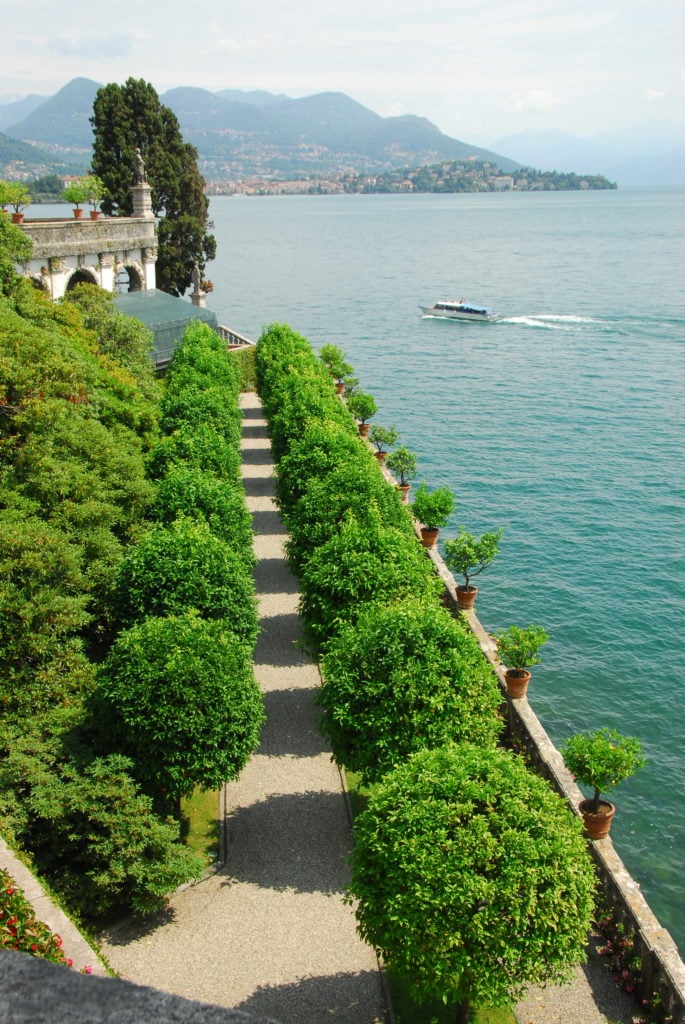There’s no doubt that Isola Bella, on Lake Maggiore, is totally and utterly over the top. What’s much harder to work out is how it gets away with this. It charms you into suspending discernment. You find yourself loving it precisely for its outrageous extravagance, and yet can’t help but feel like you’ve been taken in. Bewitched.
Certainly, I’m enchanted beyond my ability to explain.
I’m back there for about the sixth time, and my first time in mid-summer. I’ve seen it in late spring, late summer, and mid-autumn, but never now. It’s possibly not the ‘best’ moment for anything, except, perhaps, the oleanders (which, curiously, flower-like they’re on steroids, but then go fully ‘over’ as the summer progresses, unlike at home, where they take seasonally longer to get started, but then just keep going). But it’s as good as ever.
There’s a couple of natural advantages that need to be acknowledged from the start. Firstly, islands are imbued with an undeniable charm. It’s that separation, the isolation, the ‘otherness’. And then there’s the wider setting which, for which the most prosaic and modest adjective applicable would be ‘stupendous’.
But as for the garden itself, one of the great and undeniable geniuses of the place is the near-perfect extent to which the architectural detail is overrun with planting – really good planting, and good planting that is beautifully and expertly tended. We were on a funicular this morning (the day after visiting the garden) and, by chance, with another group of Aussies. One middle-aged bloke, while overlooking Isola Bella, said to the other ‘Wouldn ya just cut that tree down, if you were sittin’ in that tower?’. Only that morning I’d said to my wife that I loved how overgrown that turret was. From the other end of the crowd, I just stated ‘You’re not touchin’ that tree, mate’. He turned, and without the slightest trace of humour evident on his face, tried to work out who’d made the reply.

I doubt that the 17th-century designers of the place ever imagined it so heavily and exotically planted. The era of rich-man plant-collecting was yet to begin, and it’s likely that the intention was to have everything formally clipped in line with the fashion of the times. But to our eyes, the sense of plants leaping playfully and irreverently over such a soberly powerful structure is magical.
Then there’s the quality of the horticulture. The pots are fabulously planted and watered and fed to perfection. Plants that we’d never bother to train, such as hydrangeas (both mop-head and paniculata types) and Hibiscus syriacus are structurally disciplined to climb walls and then allowed to romp until next winter’s pruning.
I could go on and on. But it feels a bit like deconstructing love.
I’d rather just sit and bathe in its glow.



Thank you Michael for a fabulously vivid description. I was there …. in that place…. when reading. The baking sun, the herbaceous smells…. I could experience it all.
What a wonderful experience your are having.
Enjoy!
Maureen
Highcroft Garden
I’ve not visited it, but have seen it in books (and movies). I can see entirely why you love it. There is also a quality of the light in Italy, at several times of the day, which somehow makes everything more magical. But oh, those hydrangeas! To die for – and they are in full sun! As you recommend, planting en masse works, and this is a prime example. At the other end of the season, I have just pruned my own hydrangeas, and was delighted to discover that I had inadvertently produced several new plants by allowing low-growing branches to air-layer themselves, with a healthy lot of roots. They have been transplanted into good relatively shady spots.
Now I have another holiday destination…
Dear Michael, Have you seen the photographs of Isola Bella taken by Chris Koller a Fine Art photographer. His work can be found on Instagram or in his web site http://christopherkoller.net/selectedworks/23/#
His photographs are beautiful.
We loved, loved loved it.